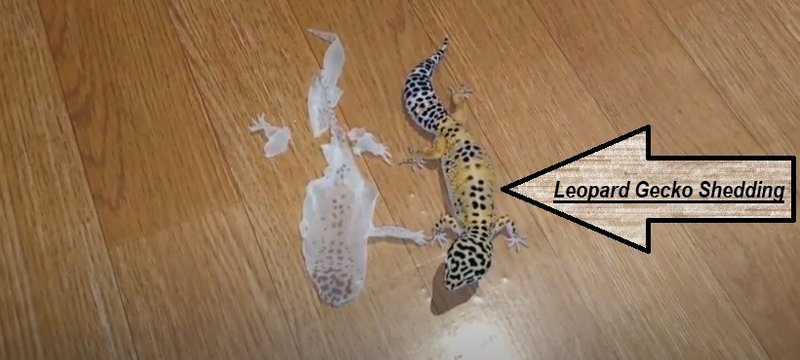
So, if you’re new to the leopard gecko world and have been wondering how to handle this shedding properly, you’re in the right place. Managing your gecko’s shedding isn’t just about keeping your tank clean; it’s also about keeping your little buddy happy and healthy. Let’s dive into why shedding happens and how you can support your gecko during this process.
Understanding the Shedding Process
Shedding, or *ecdysis*, is a natural part of a leopard gecko’s life. Just like how we might outgrow our clothes, geckos shed their skin to accommodate their growing bodies and to remove parasites or damaged skin. You might notice the shedding process occurring every few weeks, especially in younger geckos that are still growing. It can be fascinating to watch—like unwrapping a present, only the gecko is the gift!
Typically, the shedding process starts with your gecko becoming a bit dull in color. You might see them rubbing against rocks or the tank decor, trying to help the old skin come off. It’s important to know that not all shedding is smooth sailing. Sometimes, a gecko can get stuck with bits of old skin, especially around their toes or tail. This can be uncomfortable and even harmful.
Signs Your Gecko is About to Shed
So, how do you know when your leopard gecko is about to go through this transformation? Here are some signs to watch for:
- Dull Skin Color: As mentioned, right before shedding, your gecko may lose its vibrant colors.
- Increased Hiding: If your gecko spends more time in its hideouts, it might be gearing up for a shed.
- Decreased Appetite: Some geckos lose interest in food when they’re about to shed, so don’t be alarmed if this happens.
- Rubbing Against Objects: This is a natural behavior they do to help remove old skin.
Keeping an eye out for these signs can help you prepare for the shedding process. It’s like watching for a storm—you know it’s coming, and you can take action to make sure everything’s ready.
Creating a Comfortable Environment
One of the best ways to support your leopard gecko during shedding is by ensuring they have a comfortable environment. Think of it as providing a cozy blanket on a chilly night. Here’s how you can create the perfect setup:
1. Humidity Levels: Leopard geckos need a bit of moisture when shedding. Aim for humidity levels between 30-40%. This can be achieved by lightly misting the tank or providing a moist hide filled with damp sphagnum moss. Just make sure it doesn’t get too soggy!
2. Temperature Gradient: Your tank should have a warm side and a cool side. The warm side helps with digestion and encourages shedding, while the cool side provides a place for your gecko to cool off. A temperature of 88-92°F on the warm side and 75-80°F on the cool side is ideal.
3. Hiding Spots: Make sure there are plenty of hiding spots and climbing surfaces. This gives your gecko options to feel safe and secure during the shedding process.
Remember, a happy gecko is a healthy gecko. If they feel secure in their home, they’ll have an easier time shedding.
How to Assist Your Gecko When Shedding
Sometimes, despite your best efforts, your leopard gecko might still have trouble getting rid of old skin. Don’t panic! Here are a few ways you can help:
– Moist Hide: If you notice your gecko struggling to shed, place them in a moist hide. This can assist them in loosening any stuck skin. Just make sure it’s not too wet; you want a damp environment, not a soaking one.
– Gentle Assistance: If there are still stubborn skin pieces left that they can’t seem to shake off, you can gently help them. Never pull or tug at the skin. Instead, use a damp cloth to gently wipe away the remnants.
– Bathing: If all else fails, give your gecko a shallow bath in lukewarm water. Let them soak for about 10-15 minutes. This can loosen the old skin. Just keep a close eye on them to ensure they’re safe.
Remember, patience is key! Sometimes, your gecko just needs a little extra time and care to get through the shedding process.
Post-Shedding Care
Once your leopard gecko has shed completely, the care doesn’t stop there. Proper post-shedding care is just as important as the shedding itself. Here’s what to consider:
– Check for Residual Skin: After shedding, examine your gecko closely. Make sure there’s no old skin stuck, especially around their toes, tail, or eyes. If you notice anything, gently assist as mentioned earlier.
– Hydration and Nutrition: It’s common for geckos to be a bit thirsty after shedding. Provide them with fresh water immediately, and once they’re settled, you can offer a nutritious meal.
– Monitor Behavior: Keep an eye on your gecko in the days following the shed. A change in behavior—like lethargy or refusal to eat—could indicate stress or retained shed. If concerns arise, don’t hesitate to consult a vet.
Your leopard gecko’s health and comfort shouldn’t be afterthoughts. Paying attention even after they shed is key to keeping your little buddy happy.
Handling leopard gecko shedding properly is all about understanding, patience, and creating the right environment. Just like a new outfit can boost our confidence, a successful shed can make your gecko feel refreshed and rejuvenated.
By keeping an eye on their signs of shedding, ensuring they’re comfortable, and providing gentle assistance when needed, you’ll not only make shedding smoother, but you’ll also strengthen the bond between you and your pet. Remember, every little effort counts!
So, next time you see your gecko’s dull skin, embrace it as an opportunity to enhance their care. With a little love and attention, you’ll be helping your leopard gecko thrive during every shedding season.
